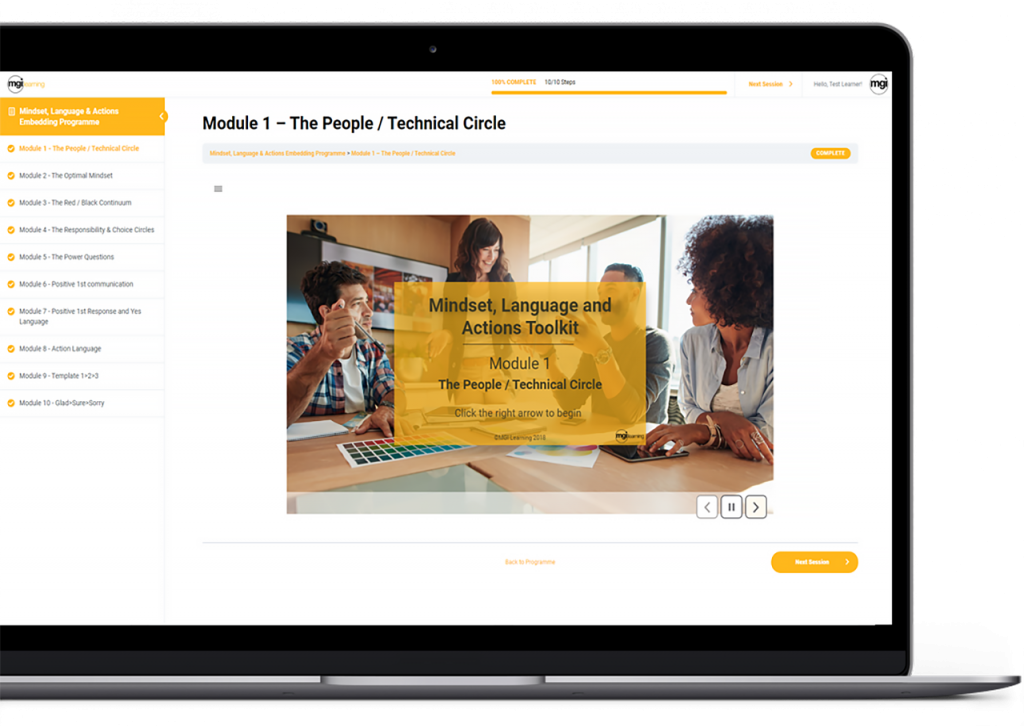One thing we know is true here at MGI Learning, is that significant business metric improvements are born from effective training. We mean more than just a successful training programme. What is needed is a fully effective, embedded, positive and obvious change in the way people operate and the organisational culture as a result of the training delivered. The enormous power of impactful training and skills development is the ability to drive true transformational change, long-term cultural improvements and ultimately a more successful business.
Ensuring new skills become a way of life for your people takes focus and dedicated embedding activity. A practical approach is required when enhancing or changing any behaviour, which is easy to understand, easy to practice, and easy to implement. How many times have you felt that the impact of a training programme was lacking? Or short-lived? Have you been on training courses and forgotten what you learnt a few weeks later (we have!)? Most likely, it’s happened because the training was delivered in silo without the wrap-around embedding support that is the vital ingredient to creating lasting behavioural change.
The steps to changing behaviour
If you are working with a training provider, ask them how they plan to ensure the training will stick? How will they secure long-term positive impact and use of the skills they are teaching? At MGI Learning, our programmes are underpinned by a deep understanding of the steps to changing behaviour. This is vital to design a compelling and complete learning journey, that includes activities before and after the training course itself.
Before the training programme is implemented, it’s crucial to ensure your people understand the “why” behind it and have both the desire to undertake the learning and the optimistic view that it’s worthwhile for them. Without this, you may face pessimism about the effectiveness of the training and lack of engagement from employees. Once the training session is in progress, it must be easy to take part in and participate, and be stimulating and engaging to encourage interaction. This will help overcome common barriers to taking part such as the training being too complicated, or the participants lacking the motivation. Post-training, it’s essential to ensure orchestrated follow-on activities are put in place. This is the vital stage where you begin the work of embedding, through positive reinforcement for using the skills and by supporting the development and use of their newly-gained knowledge in everyday situations.
Why embedding is so important to a successful outcome
Actual behavioural change is achieved through the constant, consistent and collective use of the skills and tools, which creates a culture of trust where everyone demonstrates the necessary behaviours and believes their team members will do a great job.
Embedding activities of any employee training programme need to support your people in the following areas:
- To ensure managers lead by example
- To continuously learn the skills and use the tools
- To practice using the skills in day-to-day real-life situations
- To refresh knowledge and understanding
- To see and experience the positive outcomes of using the skills
- To maintain motivation to use the skills
- To provide the tools needed to use the skills everyday practically
- To collectively use the skills as a team sharing successes and learning from each other
- To measure their use of the skills and identify any barriers to their use and areas of development
Ultimately you want your people to be motivated and bought into using their new skills knowing that they are adding value to their day-to-day work. To check how your people are doing and how effectively the embedding is working you can ask the following questions and take action on the invaluable data you will collect as a result:
- “What did I think about it?” – allow for immediate feedback alerting you to what is going well and any barriers
- “What do I remember?” – analyse immediate knowledge recall
- “How confident am I?” – Self-assessment of learning, identifying gaps
- “What extra support do I need?” – deepening activities like guides, group work, refresher training
- “What did I learn?” – test understanding and application to really show the benefit of taking part
Ten embedding tactics to ensure the skills stick
There are many elements to include in a rounded training programme to ensure the learning journey continues to move forwards and develop. Together, these will help drive positive change, ensuring your people believe in, and see the value of, using the skills they have been taught.
Here are ten tactics you can implement to ensure the skills stick:
- Refresher training – continuous, scheduled re-visiting of the training and tools and a regular basis.
- Micro-learning – short, sharp bite-sized learning sessions to deepen knowledge.
- Practice sessions – practising the skills in everyday situations and scenarios.
- E-learning – accessible online teaching, accessible to all, anytime and on any device.
- Practical tools – frameworks, processes and interactive tools to use in everyday application.
- Digital and printed materials and resources – available to recall when needed or refer to in the moment.
- Group huddles – group sessions as a team to discuss, collaborate on and practice the skills.
- Lead by example – management must demonstrate the use of the skills themselves and help mentor their people in using them.
- Measurement – ensure development and progress is regularly measured and any knowledge or support gaps are identified and dealt with.
- Reinforcement and feedback – show positive reinforcement for using the skills such as praise or rewards, ensure your people can always see the positive outcomes and listen to, and act on, their feedback along the way.
The next time you implement a training programme ask yourself – How do I know it’s really making a difference to my business metrics? Are my people truly bought into it? Will things have changed six months from now and how can I sustain that change? If there is any doubt, take a look at your embedding plan and see if you can include some of the suggestions here.
If you need to help your people adapt to change, build stronger working relationships or self-manage their wellbeing, get in touch for a free consultation so we can show you how.








